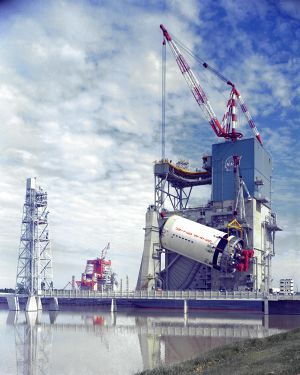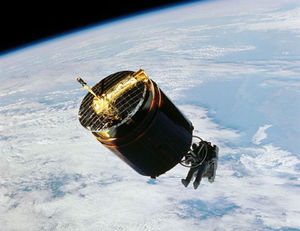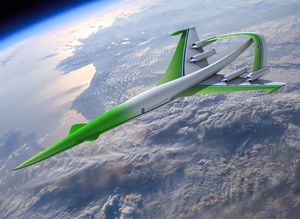National Aeronautics and Space Administration
 There's something missing here… There's something missing here…This page is a Wikipedia or SolStation data dump with little relation to the situation in Fenspace. You can help FenWiki by expanding this page. |
| National Aeronautics and Space Administration | |
| Established | July 29, 1958 |
|---|---|
| Headquarters | Washington, DC, Earth |
| Primary spaceport | John F. Kennedy Space Center, Titusville, FL |
| Motto | For the Benefit of All |
| Website | www.nasa.gov |
The National Aeronautics and Space Administration, or NASA, is perhaps the most well known of the 'Dane space agencies. Alongside its counterpart the Soviet Space Program, NASA was responsible for much of what we consider the early history of space flight.
Contents
History
NASA was established by the National Aeronautics and Space Act on July 29, 1958, replacing its predecessor, the National Advisory Committee for Aeronautics (NACA). The agency became operational on October 1, 1958.
After the Soviet space program's launch of the world's first artificial satellite (Sputnik 1) on October 4, 1957, the attention of the United States turned toward its own fledgling space efforts. Several months of debate in the US Congress and among President Eisenhower's advisers, produced an agreement that a new federal agency was needed to conduct all non-military activity in space.
From late 1957 to early 1958, the National Advisory Committee for Aeronautics (NACA) began studying what a new non-military space agency would entail, as well as what its role might be, and assigned several committees to review the concept.
In April 1958, Eisenhower delivered to the U.S. Congress an executive address favoring a national civilian space agency and submitted a bill to create a "National Aeronautical and Space Agency." NACA's former role of research alone would change to include large-scale development, management, and operations. The U.S. Congress passed the bill, somewhat reworded, as the National Aeronautics and Space Act of 1958, on July 16. On July 29, 1958, Eisenhower signed the National Aeronautics and Space Act, establishing NASA. When it began operations on October 1, 1958, NASA absorbed the 46-year-old NACA intact; its 8,000 employees, an annual budget of US$100 million, three major research laboratories (Langley Aeronautical Laboratory, Ames Aeronautical Laboratory, and Lewis Flight Propulsion Laboratory) and two small test facilities.
Major Programs
Manned Programs
- Project Mercury 1958-1963 Intended to determine whether manned space flight was possible.
- Project Gemini 1965-1966 Conducted experiments and developed technologies and methods required for the moon landings.
- Apollo Program 1961-1975 A series of missions which culminated in six moon landings
- Skylab 1973-1979 The United States' first space station.
- Space Shuttle Program 1985-2010 The development of a frequently-launchable, mostly-reusable lift vehicle.
- International Space Station 1998-2013 An orbiting laboratory built in conjunction with several other national space agencies.
Unmanned Programs
Note: Currently dates are for launches, not end of missions
- Mariner program 1962-1973 A series of 10 probes intended to investigate Mars, Venus, and Mercury. Mariners 1, 3 and 8 were lost during or shortly after launch.
- Pioneer program 1958-1978 A series of probes intended for planetary exploration.
- Voyager program 1977 A pair of probes launched to explore the outer solar system.[2]
- Viking program 1975 Two craft, each consisting of an orbiter-lander pair for Martian exploration.
- Helios probes 1974 & 1976 Two probes launched into heliocentric orbits to study the sun.
- Hubble Space Telescope 1990 A space telescope, famous in its earlier years for a mirror defect that produced blurred images. Since its repair in 1993 it has been one of NASA's best PR generators.
- Magellan probe 1978 The probe that produced the best high resolution maps of the Venusian surface before Fen exploration.
- Galileo probe 1989 The first probe dedicated to the exploration of the Jovian subsystem.
- Mars Global Surveyor 1996 A Mars probe intended for high resolution mapping and geological exploration.
- Mars Pathfinder 1996 A mobile rover designed for Mars exploration. The lander was dedicated as the Carl Sagan Memorial Station, the rover Sojourner.
- Mars Exploration Rovers 2003 Two rovers, Spirit and Opportunity.[3].
- New Horizons probe 2006 A probe intended to study Pluto and its moons. Assuming no Fen interfere with its mission, it will arrive at Hades Station on 14 July 2015.
(History from Wikipedia)
The Dawn of the Wave
With the advent of Handwavium, the American government's reaction and the Fen starting space exploration on their own NASA's fortunes took something of a tumble. Due to their not being able to use Handwavium by government order, they were unable to compete with the cheap lift capacity any Fan with a 'waved car could provide.
A second major blow was the establishment of the TSAB, whose job NASA's director had unsuccessfully argued should have been NASA's and whose monopoly on legitimate access to various technologies essentially spelled the end of NASA's space program. NASA continued to do scientific research, design and build satellites[4] and plan missions to various locations both inside and outside of the Sol system. However, they mostly contracted Fen to do the lifting and hauling, and the astronaut corps has been completely gutted. Continued funding cuts and declining prestige put NASA's future in doubt.
The last remnants of NASA's space program were absorbed by the TSAB and the Artemis Foundation after the Artemis Foundation's formation in 2014. Much to the TSAB's disappointment, the Artemis Foundation acquired a great deal of NASA's space-exploration infrastructure, including the shuttles and a long-term lease on the Kennedy Space Center. A noticeable minority of NASA's employees, mostly from the space administration side of the agency, were hired by the Artemis Foundation and continue their work for their new employer.
The so-called "demise of NASA" was met with mixed reactions among the Fen. Because of the large role played by the agency during the early years of space exploration, there is a certain fondness and nostalgia for it. However, many Fen also blame NASA for screwing up space exploration and essentially ending large 'dane space programs[5] before the wave took off.
NASA is still in operation, concentrating on aeronautics studies and space-activity regulation.
Notes
- ↑ Pioneer H was never launched.
- ↑ As of August 2009, Voyager 1 is ~110.7 AU from Sol, and Voyager 2 is ~89.7 AU from Sol. Neither accelerated to FTL after passing the Limit because they were not under powered flight.
- ↑ Opportunity has since been handwaved, becoming an AI working for the Mars Terraforming Project.
- ↑ Or at least continued to contract their designs and building out.
- ↑ The fairness of this position is hotly debated, but most sides agree that the US Congress and the Presidential branch of government did NASA no favours.
| ||||||||||||||||||||


